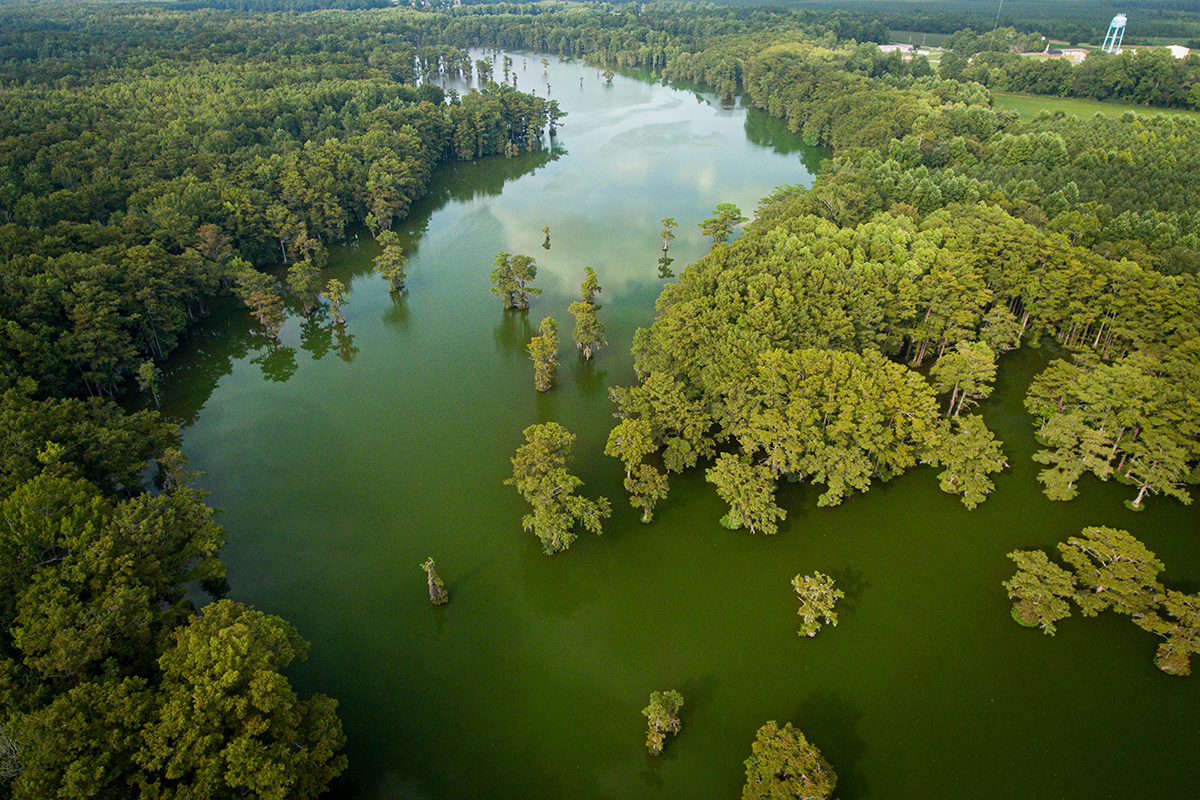
This is the third in a multipart special reporting series on coastal water quality. Read more.
Assaults on the environment may be imperceptible for a period of time, but eventually natural imbalances will become evident.
Supporter Spotlight
In the quiet fresh waters of the Chowan River basin, its unhealthy water quality is illustrated all too well during the summer by blue-green algal blooms, whether creeping along the shoreline or exploding shore to shore.
“They were really bad in 2015,” said Colleen Karl, chair of the Chowan Edenton Environmental Group, or CEEG. “It started in Edenton Bay. The water was turquoise.”
Algae, which are photosynthetic microorganisms, are natural inhabitants of waterways. But when conditions are off-balance, they can quickly multiply to harmful algal blooms.
Until six years ago, the Chowan basin’s river and creeks had not had any significant blooms since the 1970s, which were linked to discharges from a paper manufacturer. The problem with algal blooms this time has persisted, but no one is sure what exactly is triggering them, beyond unhealthy amounts of nutrients.
“We know the nitrogen levels are very high,” Karl said. “The big question now is we don’t know enough because these are fueled by so many different things.”
Supporter Spotlight
And blooms are now starting to pop up in new spots in the Little, Perquimans and Pasquotank rivers and their tributaries.
Some culprits could be leaking septic systems, fertilizer or animal feed, Karl said, but whatever the source, the problem is exacerbated by warmer waters and rising seas due to climate change.

“There seems to be more blooms after rain events,” she said. “But the stuff is here. The biomass is here. It doesn’t take much for these to explode.”
The North Carolina Department of Environmental Quality issued an advisory Aug. 2 warning the public to avoid contact with blue or green water at Arrowhead Beach to Rockyhock in Chowan County and Colerain in Bertie County.
The state determined that the bloom was dominated by cyanobacteria, which is known as blue-green algae that can contain toxins and create health hazards in humans and animals, including liver damage. Not only is swimming and boating hazardous, health officials say, any exposure to skin should be rinsed with soap and water as soon as possible.
Karl said more than once she has observed people kayaking and canoeing through waterways thick with algae.
A recent bloom at Bennett’s Millpond formed green mats of algae that coated the surface.
“Be aware that this body of water is full of blue-green algae that may or may not be toxic,” Karl posted Sept. 1 on the CEEG Facebook page. “The smell of degrading algae was strong even though we all were wearing N95 masks. It is heartbreaking to see our beautiful waterways in this condition.”

Risks to human health
Health effects of blooms are not fully understood, including the short-term and long-term dangers of certain levels of exposure to certain toxins in the algae. For example, an algal bloom was cited as one possible cause for the recent mysterious deaths near Yosemite National Park of a family of hikers and their dog.
Little is known about the health effects of breathing airborne cyanobacteria toxins, Haley Plaas, a doctoral student in environmental sciences and engineering at the University of North Carolina Chapel Hill’s Institute of Marine Sciences in Morehead City, said in a recent interview.
Plaas, who has been researching the aerosol effects since 2020, said that Karl and other community scientists with CEEG have helped with providing study sites and water samples of blooms. In fact, she said she had visited Bennett’s Millpond in late August to take water and air samples.
New equipment, an odd-looking 4½-foot-tall steel body with a mushroom-shaped head, has been deployed on private property to collect aerosol particles. In addition to her writing a manuscript about her work in a peer-reviewed journal, Plaas said that the data will be analyzed to determine details such as the identity and concentration of the toxins, and what environmental factors may have contributed to its presence. Also, the raw data will be released to an open source database.
All sorts of different kinds of algae are known to create toxins, she said, or harnful algal blooms, although not every algal bloom is toxic. Because the data only go back 30 years, Plaas said, it’s not yet known whether algal blooms are becoming more toxic.
In general, blooms are increasing worldwide not only because of warming associated with climate change, but also because there is more nutrient pollution. Researchers hypothesize that one reason for the Chowan’s blooms could be linked to changes in land use that reduced swampland and wetlands — riparian buffers — that would otherwise be there to suck up excess nutrients.
Sources of the nutrients can be hard to pinpoint, much less control, Plaas said, and there also is a lack of epidemiological research on the harm of toxic algal blooms, in part because it so difficult to do.

“Basically, you can be exposed to these toxins by swimming in the water, or eating food (such as fish), or drinking the water, or inhaling it,” she said. “People in North Carolina are most likely exposed in recreational activities.”
But the symptoms — nausea, vomiting, rashes — overlap with symptoms associated with numerous other maladies.
“By the time someone got sick, it may be two or three days after the exposure. Then it can seven days after exposure when a doctor rules out other causes,” she said. Then there’s the complication of collecting the sample and testing it. Since blooms can not only move, they can come and go before anyone has a chance to take a sample, and there aren’t staff available to sample and test every bloom in a state as large as North Carolina.
Research is underway to develop a real-time sensor, she said. But meanwhile, there is a networking system in place that includes cell phone apps and community scientists who report blooms and take samples when possible. There are also existing digital tracking and mapping tools for harmful algal blooms.
With algal blooms becoming more of a concern globally, the recurrent blooms in the Chowan River have spurred more attention from the scientific community.
A part of the Albemarle-Pamlico Estuarine system, the nation’s second largest behind the Chesapeake, the Chowan basin’s waters are designated as Nutrient Sensitive Waters, due to the way they flush and drain.
The 2021 Chowan River Basin Water Resources Plan was approved in March by the state Environmental Management Commission. Basin plans are required by state law and approved every 10 years by the commission. Among the priorities for the plan is management and/or reduction of recurring algal blooms in region, which will require more data collection and review, said Division of Water Quality spokesperson Anna Gurney, responding to Coastal Review.
Implementation of the plan will involve interstate cooperation and best management practices to reduce the amount of nutrients entering the system, such as from wastewater and stormwater. Another important component of the plan is public engagement.
“Communicating the science will create interest and action to protect water resources,” Gurney wrote, adding that several basin stakeholders are already involved in the effort.
“Northeastern North Carolina, like many other parts of the State, are working with limited resources; however, the people are passionate!” DEQ/DWR Basin Planner Forest Shepherd said in an email. “The citizens are concerned about their waters and expressed it through the multiple public comment letters we received during the development of the Chowan and Pasquotank River Basin Water Resources Plans. These plans are tools to assist with public education, outreach, and engagement; which is vital to successful protection of these water resources.”
Karl, who has a background in science, said she sees a need for much more communication with the public, as evidenced by the folks she saw fishing and boating in Bennett’s Millpond.
“Literally, the water was pea green,” she said. “Where were the signs? Not a lot of people are aware of what these toxins can do.”
The county didn’t post any warning about the bloom on its website, Karl said, and the water resources press release has limited reach.
“Who sees that?” she asked. “Unfortunately, we don’t have any way to get the word out.”
Although she credited the progress of North Carolina’s researchers and officials, Karl said that everyone is spread thin and under-resourced. New York is an example of a state that does a better job of networking and reporting blooms, as well as using citizen scientists, she said.
“They seem to be able to get the word out wider,” Karl said. “It takes people. It takes money.”







